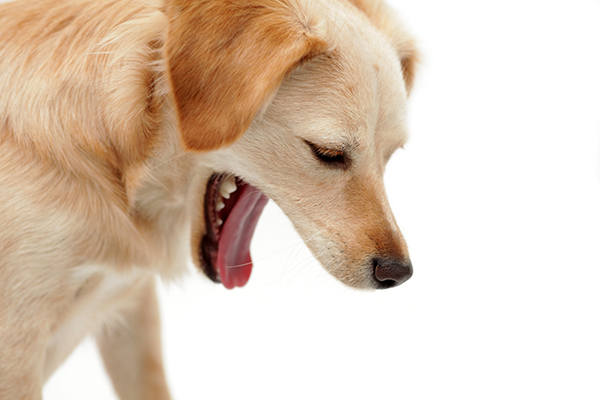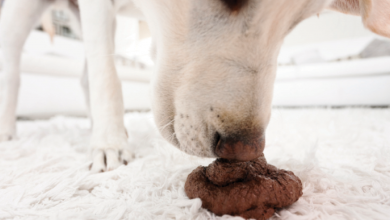Is Your Dog Vomiting Blood? Here’s What to Do Next

[ad_1]
Picture this: It’s 11 p.m. on a Saturday night. You’re roused from your slumber by the sound of your dog throwing up all over the bedroom floor. With a deep sigh, you crawl out of bed, flip on the light and kneel down to clean it up. But wait, you see something dark-colored in the vomit. Blood. Your heart skips a beat. Your dog is throwing up blood. Is a dog vomiting blood life threatening? Do you need to rush your dog straight to the emergency clinic?
What to do about a dog vomiting blood
What are the next steps to take for a dog vomiting blood? Photography ©Rasulovs | Thinkstock.
A dog vomiting blood can be a sign of a serious emergency or a minor problem. “It sounds gross, but you should look closely at the vomit,” says Kelly Diehl, DVM, Dipl. ACVIM, scientific communications advisor for the Morris Animal Foundation, a nonprofit foundation that funds animal health research. “Is it a just a thread or a few streaks of red blood? Is it a volume of fluid that’s very red, like fruit punch? And is there anything that looks like coffee grounds?”
A small amount of red blood in your dog’s vomit could be caused by simple stomach irritation. “If [your dog has] an upset stomach and [he’s] been vomiting a lot, the stomach becomes so irritated that [he] can have a little bleeding,” Dr. Diehl explains. “Sometimes, we see stomach bleeding in pets that are taking non-steroidal [anti-inflammatory] drugs.” So, a dog vomiting blood that looks like just a few flecks or streaks of red blood is not necessarily very serious. As long as the bleeding and/or vomiting doesn’t get worse, you could potentially wait until the next day to contact your vet.
Is your dog vomiting blood and exhibiting these symptoms?
In some cases, a dog vomiting blood necessitates an immediate trip to your veterinarian (or the emergency clinic, if it’s after hours). A dog vomiting blood that is uniformly bright red signifies a large amount of bleeding. Black or dark-brown blood that looks like coffee grounds indicates the bleeding has been going on for a long amount of time, so that is very concerning. “A lot of people don’t realize that’s dried, partially digested blood,” Dr. Diehl explains. “That is almost always serious, even more serious than a streak of red blood.”
Another factor to consider with a dog vomiting blood is your dog’s demeanor. Is your dog acting fairly normal other than throwing up blood, or is he very lethargic and depressed? A dog vomiting blood who is also acting very sick should go to the vet immediately, even if it’s the middle of the night.
Additionally, a dog vomiting blood should be checked for other sources of bleeding. “For example, if [your dog] ate something like rat bait, that can cause [him] to vomit blood, but [he’s] usually bleeding somewhere else, too,” Dr. Diehl says. “[He] might be bleeding from the mouth or the nose and swallowing it. Any kind of bleeding that doesn’t seem to be slowing down, from the nose or the mouth, or any other signs of bleeding, including bruising on the skin or passing blood in stool, is an emergency. You don’t wait — you go right in.”
The bottom line on vet attention for a dog vomiting blood
The answer is easy with a dog vomiting blood during normal business hours. Call your veterinarian, describe the blood you saw, and ask if your dog needs to come in immediately or if you can take a wait-and-see approach.
However, if your dog is throwing up blood after business hours, consider the appearance and the amount of blood, how your dog is acting, and whether he has any known medical issues or is taking any medications that might be contributing to the bleeding. “If it’s really a lot of red-looking vomit, versus a streak or flecks, you should come in right away,” Dr. Diehl advises. “When you see that much bleeding, you should go in, even if your pet seems to be okay. And if your dog starts feeling really lousy, even if you’ve just seen a little bit of blood, you should go in right away.”
If you choose to wait until morning, always call your vet to report what you saw, even if your dog seems to be feeling better. “Don’t ever just completely blow it off,” Dr. Diehl says. “Even if you don’t see the blood anymore, call and talk with your veterinarian about what your next step should be.”
Tell us: Have you ever dealt with your dog vomiting blood? What caused your dog to vomit blood and how did you treat it?
Thumbnail: Photography by Kickers / iStock.
This piece was originally published in 2018.
Did you know? Vomiting blood or coffee-like material can be a sign of gastritis in humans. Find out more >>
About the author
Pet expert Jackie Brown has spent 20 years following her passion for animals as a writer and editor in the pet publishing industry. She is contributing writer for National Geographic’s Complete Guide to Pet Health, Behavior, and Happiness: The Veterinarian’s Approach to At-Home Animal Care (April 2019) and author of the book It’s Raining Cats and Dogs: Making Sense of Animal Phrases (Lumina Press, 2006). Jackie is a regular contributor to pet and veterinary industry media and is the former editor of numerous pet magazines, including Dog World, Natural Dog, Puppies 101, Kittens 101 and the Popular Cats Series. Prior to starting her career in publishing, Jackie spent eight years working in veterinary hospitals where she assisted veterinarians as they treated dogs, cats, rabbits, pocket pets, reptiles, birds and one memorable lion cub. She lives in Southern California with her husband, two sons and miniature poodle Jäger. Reach her at jackiebrownwriter.wordpress.com.
Read more about dog health on Dogster.com:
[ad_2]
Source link






